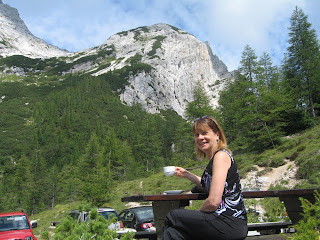

Yesterday morning we finally backed away from the buffet, checked out of our hotel and caught the local bus to Porec at 10 am. We were there before 11 and got our tickets to Ljubljana. The bus didn't leave until 2:30 pm so we lounged in the park by the bus station and just behind the marina. Since we didn't want to carry our packs we took turns walking around the marina and seaside promenade, which is very nice. The time actually passed fairly well.
Our bus stopped in quite a few towns up the coast to Koper, in Slovenia. Crossing the border only took a few minutes. Since it was a hot, sunny August Sunday, every little beach looked busy. Some, like Portorusz, made us glad we hadn't stayed there, they were so packed with people. The traffic on the little coastal road was heavy as well.
Once we got on the main highway to Ljubljana, the trip went much faster. We arrived in Ljubljana a little after 6 pm and walked less than 10 minutes to the hotel we had used here before, which we had already reserved.
Since we were really tired from the trip, we had a quick shower and walked down to the old town for a light dinner. We went to a restaurant we had been at before for pizza, which was good once again. Then we were home shortly after 9 for a good night's sleep. We have a room facing the street this time so it's a little noisy but it didn't really bother us.
Today, after some fruit and nuts in our room, we set off to find a bank, of which there are many, to change our leftover Croatian kuna into euros. It seemed awfully quiet for a Monday morning. Finally, we learned that today is the Assumption of Mary national holiday in Slovenia. We had read that before but forgotten about it. Anyway, the currency exchange at the train station was open so we were okay.
After about 11 or so, things started to open up. All of the offices and many stores are closed but there are lots of restaurants and a few grocery stores open.
We had coffee and ice cream on an outdoor patio overlooking the river and then wandered around a bit. After a brief stop back at our hotel to pay the bill in euros, we bought a beer and a burek around the corner and ate lunch in a park. Then we went along the main street of the old town to find a suitable restaurant for dinner. We have two possibilities, both of them specializing in traditional Slovenian food.
It's a fairly hot day so we're just cooling off in our room before dinner. Tonight we'll pack up and be ready to go out the door before 5 in the morning. We'll catch the 5:20 shuttle to the airport from the bus/train station. Our Adria Airways flight to Zurich leaves at 7:45 arriving there at 9:00. It's a small plane and if the weather is clear like it was when we arrived, we'll be able to look down on the Alps pretty well all the way.
Then we have almost 4 hours before our Swiss Air flight leaves at 12:50. It's an 8 hour and 10 minute flight to Montreal arriving at 3 pm. By the time we get our luggage and get through customs we'll either get a 4 or 5 pm bus arriving in Ottawa at 6 or 7 pm. Dylan will pick us up so we should be home by 9:30. Altogether it will be about 23 hours devoted to getting home. Wednesday might be a slow day.
We've had lots of adventures and had a good taste of Slovenia and Croatia. We're very happy with the trip but home won't be so bad either.

















































